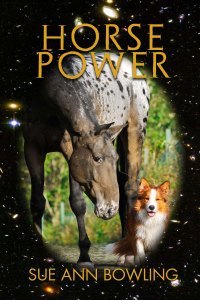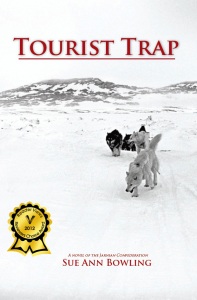As a final summary of horse color genetics, let’s go over the loci, what they do, and the alleles at each locus. My primary reference is Sponenberg.
 The Agouti locus is widespread in mammals, and is involved with whether and where an animal produces eumelanin (black) or phaeomelanin (red) pigment. The alleles known in horses, listed with the most dominant first, are Wild Bay (Wild-type), Bay, Seal Brown and black. Agouti is hypostatic to Extension, meaning that the effects of the agouti alleles can be seen only if the extension gene allows the animal to produce both eumelanin and phaeomelanin. Note that at this locus, the redder the color, the more dominant.
The Agouti locus is widespread in mammals, and is involved with whether and where an animal produces eumelanin (black) or phaeomelanin (red) pigment. The alleles known in horses, listed with the most dominant first, are Wild Bay (Wild-type), Bay, Seal Brown and black. Agouti is hypostatic to Extension, meaning that the effects of the agouti alleles can be seen only if the extension gene allows the animal to produce both eumelanin and phaeomelanin. Note that at this locus, the redder the color, the more dominant.
 The Extension locus is the same as the melanocortin receptor one locus, or MC1R. Like agouti, it influences whether eumalin or phaeomelanin gets into the coat and occurs in most mammals. The alleles are dominant black (still not confirmed), wild-type, and chestnut. This locus may also have genetic control over the depth of black tipping. Only wild-type and tipping allow the agouti genes to show. In this series, more black is dominant over more red. Extension is epistatic to agouti.
The Extension locus is the same as the melanocortin receptor one locus, or MC1R. Like agouti, it influences whether eumalin or phaeomelanin gets into the coat and occurs in most mammals. The alleles are dominant black (still not confirmed), wild-type, and chestnut. This locus may also have genetic control over the depth of black tipping. Only wild-type and tipping allow the agouti genes to show. In this series, more black is dominant over more red. Extension is epistatic to agouti.
Agouti and extension determine the base color of the horse—bay, brown, black or chestnut.
 The various dilution genes generally affect phaeomelanin and eumelanin differently, mane and tail hair and body hair hair differently, and not uncommonly are associated with patterns of dilution.
The various dilution genes generally affect phaeomelanin and eumelanin differently, mane and tail hair and body hair hair differently, and not uncommonly are associated with patterns of dilution.
The Dun locus has two alleles. Wild-type is dun and is dominant over non-dun, but the wild type is rare in many breeds. When present, dun dilutes both black and red pigment on the body, but the degree of dilution varies a great deal. Head, legs, mane and tail are generally much less affected than is the central body, and dorsal stripes almost always occur. “Zebra stripe” markings often occur on legs and the shoulder region. The dorsal stripe may continue down the center of the mane and tail, with the edges diluted.
The Cream locus is also known as the membrane-associated transporter protein (MATP) locus. It probably has three alleles: Wild-type, pearl, and cream. The dominance hierarchy here is complex. A horse with two wild-type alleles is normal color. A horse with one wild-type and one pearl allele looks normal color except for slightly lighter skin. A horse with two pearl alleles will have red lightened to gold and black lightened to beige. A horse with one cream allele and one wild-type allele will have red lightened to gold and black lightened only very slightly. A horse with one cream and one pearl allele will have red lightened to pale cream or ivory and black lightened to beige. Finally, a horse with two cream alleles will be a very pale color, as red lightens to cream and black to a slightly dirty white.
 The Champagne locus is the SLC36A1 locus. It has two alleles: Champagne (dominant) and wild-type. Champagne dilutes red to gold and black to brown or tan. The mane and tail are generally diluted less than is the body.
The Champagne locus is the SLC36A1 locus. It has two alleles: Champagne (dominant) and wild-type. Champagne dilutes red to gold and black to brown or tan. The mane and tail are generally diluted less than is the body.
 The Silver Dapple locus is the pre-melanosomal protein 17 (PMEL17) locus. It has two alleles, silver (dominant) and wild-type. The silver allele dilutes black strongly but has little or no effect on red. The allele also produces very strong dilution in mane, tail and lower legs, at times producing horses that appear black with white manes and tails. Far commoner are horses with a blue to chocolate body, often heavily dappled, with distinctly lighter manes and tails. At one time common primarily in ponies.
The Silver Dapple locus is the pre-melanosomal protein 17 (PMEL17) locus. It has two alleles, silver (dominant) and wild-type. The silver allele dilutes black strongly but has little or no effect on red. The allele also produces very strong dilution in mane, tail and lower legs, at times producing horses that appear black with white manes and tails. Far commoner are horses with a blue to chocolate body, often heavily dappled, with distinctly lighter manes and tails. At one time common primarily in ponies.
The Mushroom locus has not yet been located. Two alleles are suspected, wild-type (dominant) and mushroom (recessive.) Mushroom horses resemble silver dapples, but lack dappling and have tested chestnut at the extension locus.
Arab dilution is another possible locus. This is believed to be a recessive allele with a strong lightening effect on black but little or no effect on red. Both Mushroom and Arab dilution are very rare.
I will summarize patterns of white, including grey and roan, next week.




































 Buy Homecoming from iUniverse
Buy Homecoming from iUniverse















